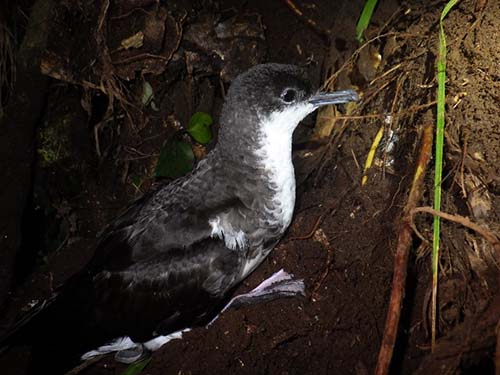Home > Research > Research Results > Research Results 2019 > Proposal for restoring the Japanese name of Bannerman’s Shearwater Puffinus bannermani
Update:October 4, 2019
Main content starts here.
Proposal for restoring the Japanese name of Bannerman’s Shearwater Puffinus bannermani
| Article title |
Proposal for changing the Japanese name of Puffinus lhermieri bannermani in the Checklist of Japanese Birds from Seguro-mizunagidori to Ogasawara-mizunagidori |
|---|---|
| Author (affiliation) |
Kazuto Kawakami (a), Masaki Eda (b), Hiroe Izumi (b), Kazuo Horikoshi (c), Hajime Suzuki (c) (a) Department of Wildlife Biology, FFPRI, Tsukuba, Ibaraki, Japan. (b) Hokkaido University Museum, Hokkaido University, Sapporo, Hokkaido, Japan. (c) Institute of Boninology, Chichijima, Ogasawara, Tokyo, Japan. |
| Publication Journal |
Japanese Journal of Ornithology, 68(1): 95-98 (2019) DOI:10.3838/jjo.68.95( External link ) |
| Content introduction |
Bannerman’s Shearwater, Puffinus bannermani, breeds in the forests of the Ogasawara Islands. It has been considered to be a subspecies of Audubon’s Shearwater, which is widely distributed across the globe, and thus has been renamed as P. lherminieri bannermani. Approximately 100 years ago, Bannerman’s Shearwater from the Ogasawara Islands was listed as a novel species and was initially assigned the Japanese name “Ogasawara-mizunagidori”. However, Bannerman’s Shearwater was later identified to be the same species as Audubon’s Shearwater because of their similar morphologies. In 1974, the former’s name was changed to “Seguro-mizunagidori” (Japanese). However, we conducted a DNA analysis in 2018, which revealed that the Ogasawara population was a unique bird species from the Ogasawara Islands and was different from Audubon’s Shearwater(note). Therefore, in the present study, we propose to change the Japanese name of Bannerman’s Shearwater from “Seguro-mizunagidori” to “Ogasawara-mizunagidori” again. As Audubon’s Shearwater is widely distributed across the globe, it may have been inappropriate to name it “Ogasawara-”, which is the name of a specific region in Japan. We assume that this was the reason why it was named “Seguro-mizunagidori” instead of “Ogasawara-”. The bird’s black back is probably the reason why it was called “Seguro-”, which means black back in Japanese. However, as per the initial classification, the bird is endemic to the Ogasawara Islands, which is not inaccurate. Currently, the bird is considered as an endangered species. Recently, breeding has been confirmed in two islands only including Higashijima and Minami-Iwoto. Restoration of the name “Ogasawara-” could raise awareness regarding its status and facilitate its conservation. The Ornithological Society of Japan decides on the Japanese names of the bird and publishes them in “Checklist of Japanese Birds,” which is regularly revised. In the next revision, we expect that the Japanese name “Ogasawara-mizunagidori” would be restored. In such a case, it is necessary to actively disseminate information and raise awareness to prevent confusion arising because of changing the Japanese name.
Photo. The bird formerly called “Ogasawara-mizunagidori” (taken at Minami-Iwoto) Note. A subspecies of Audubon’s Shearwater in the Ogasawara Islands is a cryptic species based on DNA analysis. https://www.ffpri.affrc.go.jp/press/2018/20180125/index.html |
Copyright © Forest Research and Management Organization. All rights reserved.

